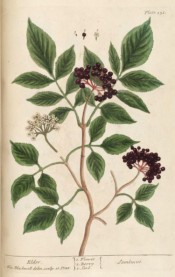Sambucus nigra L.
Fully hardy, upright bushy shrub with pinnate leaves, to 25cm long, composed of 5 toothed, ovate leaflets, and flattened panicles, to 20cm across, of small, musk-scented, white flowers in summer, followed by edible, spherical, glossy black fruit. [RHSE, Hortus, Hilliers’].
Horticultural & Botanical History
Over the centuries the elder was an important wild hedgerow crop in England, amongst other uses, both flowers and fruit making excellent wine. The spirit Sambuca is flavoured with elderberry. ‘Elder. Sambucus. This is a common Hedge Tree, & seldom grows to any great bigness. The leaves are a light grass green, the flowers white, and the berries a deep purple. It grows frequently on hedges near ditches, and flowers in May the berries being ripe in September. The bark, leaves, flowers & berries are used. The inner bark is much used for the dropsy. The leaves outwardly are good for inflammations, St. Anthony’s Fire & the piles; the flowers are used for the same, and are also put in fomentations and cataplasms for all kinds of swellings, tumours, & pains in the limbs; inwardly they expel wind, & help the cholic. The berries are cordial & useful in histeric disorders. On the trunk of this tree grows an excrescence which they call Jews Ears, being accounted good for ye swellings & inflammation of the tonsils, sore throats and quinseys.’ [Blackwell pl.151/1737].
History at Camden Park
Listed in all published catalogues [T.923/1843].
Notes
Sambucus nigra Marsh. (1785) = Sambucus canadensis L.
Sambucus nigra Lour. (1790) = Sambucus loureiriana DC.
Sambucus nigra Thunb. (1784) = Sambucus racemosa L.
Published Jul 08, 2009 - 05:03 PM | Last updated Jul 16, 2010 - 02:06 PM
| Family | Caprifoliaceae |
|---|---|
| Category | |
| Region of origin | Europe, North Africa, Asia |
| Synonyms | |
| Common Name | Black elder, Bourtree, Common elder, Elderberry, European elder |
| Name in the Camden Park Record | Sambucus nigra - Elder tree |
| Confidence level | high |


